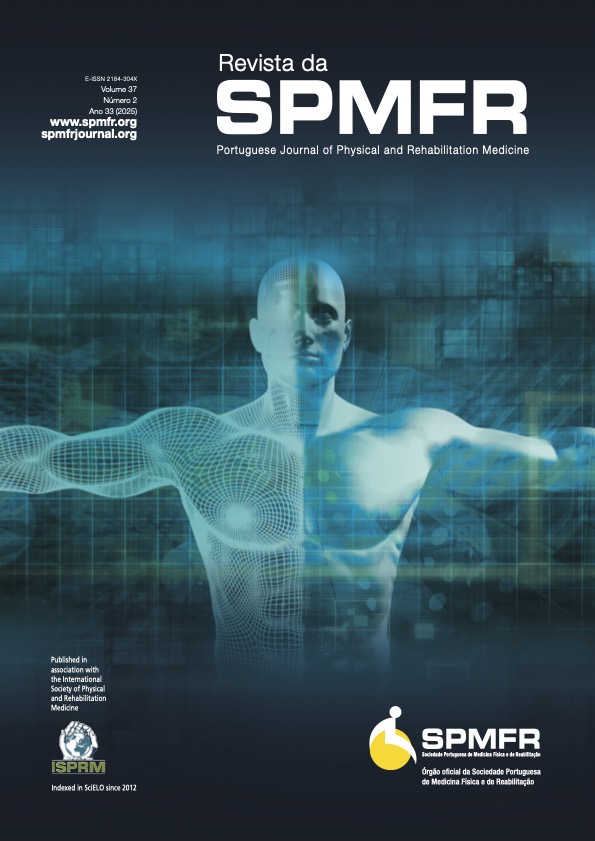Impacto da Incontinência nos Profissionais de Saúde: Destacando a Necessidade de Uma Maior Sensibilização
DOI:
https://doi.org/10.25759/spmfr.511Palavras-chave:
Incontinência Urinária, Incontinência Fecal, Profissionais de saúde, TerapêuticaResumo
Background: Urinary and anal incontinence are common conditions, although often underreported, due to the social stigma attached. This study aims to identify the prevalence and impact of urinary and/or anal incontinence among Portuguese health care providers (PHCP) and to realize if the stigma existing in the general population is also common among this group of professionals.Methods: AHcross-sectional study. Data was obtained from an online questionnaire aimed to characterize incontinence among PHCP working in a Public Hospital. The survey included questions regarding demographic data, incontinence characteristics and its impact on quality of life (QoL), the treatment and respective effect, and the search for medical care.
Results: We includedH133HPHCP, mean age of 39 years; 46 (34.59%) reported urinary incontinence, especially stress incontinence, and 7 (5.26%) reported gas incontinence, 5 of whom had anal and urinary incontinence. Only 17 of 48 PHCP (35.42%) with incontinence symptoms had undergone medical treatment, which resulted in an average improvement of 3.11 in QoL, (4.22 pre-treatment versus 7.33 post-treatment, p<0.001), on a Visual Analogue Scale (where 0 is the worst and 10 is the best QoL). Among those experiencing symptoms but refraining from seeking medical assistance, the primary reason cited was embarrassment (67.7%).
Conclusion: Despite a considerable number of incontinence cases, many PHCP do not search for medical care, even though this pathology interferes with their QoL. Nevertheless, most of those who present incontinence symptoms consider medical evaluation important. The authors suggest strategies to raise awareness of the importance of this issue among this group of professionals, including, training sessions/lectures.
Downloads
Referências
Bardsley A. An overview of urinary incontinence. Br J Nurs. 2016;25(18):S14–21. doi: 10.12988/bjpn.2016.25.18.S14 PubMed
Irwin GM. Urinary incontinence. Prim Care. 2019;46(2):233–42. doi: 10.1016/j.pop.2019.02.004 PubMed-
Pretlove SJ, Radley S, Tooze-Hobson PM, Thompson PJ, Coomarasamy A, Khan KS. Prevalence of anal incontinence according to age and gender: a systematic review and meta-regression analysis. Int Urogynecol J. 2006;17(4):407–17.
Mazur-Bialy AI, Kolomariska-Bogucka D, Oplawski M, Tim S. Physiotherapy for prevention and treatment of fecal incontinence in women: systematic review of methods. J Clin Med. 2020;9(10):3255.
Assmann SL, Keszthely D, Kleijnen J, Anastasiou F, Bradshaw E, Bramigan AE, et al. Guideline for the diagnosis and treatment of faecal incontinence: a UEQ/ESCP/ESNM/ESPCG collaboration. United Eur Gastroenterol J. 2022;10(3):251–86.
Alouini S, Memic S, Couillandre A. Pelvic floor muscle training for urinary incontinence with or without biofeedback or electrostimulation in women: a systematic review. Int J Environ Res Public Health. 2022;19(5):2789.
Aoki Y, Brown HW, Brubaker L, Cornu JN, Daly JO, Cartwright R. Urinary incontinence in women. Nat Rev Dis Primers. 2017;3:17097.
Hu JS, Pierre EF. Urinary incontinence in women: evaluation and management. Am Fam Physician. 2019;100(6):339–48.
Glazener C, Boachie C, Buckley B, Cochran C, Dorey G, Grant A, et al. Conservative treatment for urinary incontinence in men after prostate surgery (MAPS): two parallel randomised controlled trials. Health Technol Assess. 2011;15(24):1–296.
Saadia Z. Relationship between mode of delivery and development of urinary incontinence: a possible link is demonstrated. Int J Health Sci (Qassim). 2009;3(1):11–6.
Nygaard IE, Shaw JM, Bardsley T, Egger MJ. Lifetime physical activity and female stress urinary incontinence. Am J Obstet Gynecol. 2015;213(1):40 e1–10.
Frayman KB, Kazmerski TM, Sawyer SM. A systematic review of the prevalence and impact of urinary incontinence in cystic fibrosis. Respinology. 2018;23(1):46–54
Saldana Ruiz N, Kaiser AM. Fecal incontinence: challenges and solutions. World J Gastroenterol. 2017;23(1):11–24.
Chaichanavichkij P, Hartmann M, Scott SM, Fenton N, Knowles CH, Carrington EV, et al. Evaluating the risk factors for the development of benign disorders of defaecation: a surgical perspective. Tech Coloproctol. 2023;27(10):847–57.
Pizzol D, Demurtas J, Celotto S, Maggi S, Smith L, Angioelli G, et al. Urinary incontinence and quality of life: a systematic review and meta-analysis. Aging Clin Exp Res. 2021;33(1):25–35.
Miner PR. Economic and personal impact of fecal and urinary incontinence. Gastroenterology. 2004;126(1 Suppl 1):58–13.
Flalkow MF, Melville JL, Lentz GM, Miller EA, Miller J, Fenner DE. The functional and psychosocial impact of fecal incontinence on women with urinary incontinence. Am J Obstet Gynecol. 2003;189(1):127–9.
Caruso S, Brescia R, Matarazzo MG, Giunta G, Rapisarda AMC, Cianci A. Effects of urinary incontinence subtypes on women’s sexual function and quality of life. Urology. 2017;108:59–64.
Stederhecht M, Pirhonen J, Bik E, Wilsgaard T, Vonen B, Qian P. Anal incontinence, urinary incontinence and sexual problems in primiparous women: a comparison between women with episiotomy only and women with episiotomy and obstetric and sphincter injury. BMC Women’s Health. 2014;14:157.
Klimaszewska K. The social aspects of urinary incontinence of women. Pielegniarstwo XXI Wieku Nursing in the 21st Century. 2017;16(1):57–61.
Elenskaia K, Haidvogel K, Heidinger C, Doerfler D, Umek W, Hanzai E. The greatest taboo: urinary incontinence as a source of shame and embarrassment. Wen Kin Wochenschr. 2011;123(19–20):607–10.
Thompson DL, Smith DA. Continence nursing: a whole person approach. Br J Nurs. 2007;16(2):14–21.
Bragg R, Hebel D, Vouri SM, Pillick JM. Mirabegron: a beta-3 agonist for overactive bladder [Internet]. Consult Pharm. 2014;29(12):823–37. Available from: http://www.accessdata.fda.gov/scripts/cder/drugsatfda/
Wani MM, Sheikh MI, Bhat T, Bhat Z, Bhat A. Comparison of antimuscarinic drugs to beta-adrenergic agonists in overactive bladder: a literary review. Curr Urol. 2021;15(3):153–60.
Yang SJ, Liu YT, Lo SS, Tsai CC, Pan PJ. Effect of a comprehensive rehabilitation program for community women with urinary incontinence: a retrospective cohort study. Healthcare (Basel). 2021;9(12):1686.
Downloads
Publicado
Como Citar
Edição
Secção
Licença
Direitos de Autor (c) 2025 Revista da Sociedade Portuguesa de Medicina Física e de Reabilitação

Este trabalho encontra-se publicado com a Licença Internacional Creative Commons Atribuição-NãoComercial-SemDerivações 4.0.
Os manuscritos devem ser acompanhados de declaração de originalidade, Autoria e de cedência dos direitos de propriedade do artigo, assinada por todos os Autores.
Quando o artigo é aceite para publicação é obrigatória a submissão de um documento digitalizado, assinado por todos os Autores, com a partilha dos direitos de Autor entre Autores e a Revista SPMFR, conforme minuta:
Declaração Copyright
Ao Editor-chefe da Revista da Sociedade Portuguesa de Medicina Física e Reabilitação
O(s) Autor(es) certifica(m) que o manuscrito intitulado:
____________________________________________________________________ (ref.Revista da SPMFR_________) é original, que todas as afirmações apresentadas como factos são baseados na investigação do(s) Autor(es), que o manuscrito, quer em parte quer no todo, não infringe nenhum copyright e não viola nenhum direito da privacidade, que não foi publicado em parte ou no todo e que não foi submetido para publicação, no todo ou em parte, noutra revista, e que os Autores têm o direito ao copyright.
Todos os Autores declaram ainda que participaram no trabalho, se responsabilizam por ele e que não existe, da parte de qualquer dos Autores conflito de interesses nas afirmações proferidas no trabalho.
Os Autores, ao submeterem o trabalho para publicação, partilham com a Revista da SPMFR todos os direitos a interesses do copyright do artigo.
Todos os Autores devem assinar
Data:
Nome(maiúsculas)
Assinatura
Relativamente à utilização por terceiros a Revista da SPMFR rege-se pelos termos da licença Creative Commons “Atribuição – uso Não-Comercial – Proibição de Realização de Obras derivadas (by-nc-nd)”.
Após publicação na Revista SPMFR, os Autores ficam autorizados a disponibilizar os seus artigos em repositórios das suas instituições de origem, desde que mencionem sempre onde foram publicados.
OS AUTORES DEVERÃO SUBMETER UMA DECLARAÇÃO DE CONTRIBUIÇÃO / CONTRIBUTORSHIP STATEMENT INDICANDO O TIPO DE PARTICIPAÇÃO DE CADA AUTOR NO ARTIGO. Mais informações: https://authors.bmj.com/policies/bmj-policy-on-authorship/



